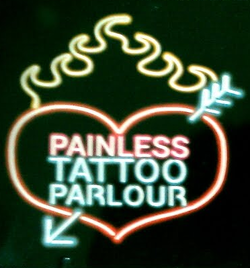
The answer is: Of course you can, what nonsense. If you can feel classy whilst sharing a Treasure Chest cocktail (and GERMS) in Mahiki you can certainly feel classy with hundreds of pounds of body art. I know which I think is the more sensible choice.
It's true in the last century tattoos became associated with a certain demographic. Former writer in residence at HMP Preston Amanda Wait photographed prisoners' tattoos and recorded the stories behind them in Marked Men. One prisoner mentioned his body art was: “the one thing they can’t take off you in reception.” These ranged from biro and needle efforts excecuted in a children's home to expensive back pieces that sharply depicted Japanese koi fish.
But tattoos have had their indelible mark (ha-ha) on the Western world for longer than some may care to acknowledge. Specifically the Fancy Western World; tucked away on Queen Victoria's intimate area (allegedly), displayed on George V's forearm and snaking around Lady Randolph Churchill's wrist. All of whom, at a wild guess, attended Royal Ascot at one time or another.
The gloriously named Margot Mifflin (who if the chance ever comes up I shall marry immediately and adopt her name.) wrote Bodies of Subversion in 1997 about women and tattoos. Citing their popularity among suffragists and 1970s feminists. The Western world has certainly been fascinated by women and tattoos as demonstrated by this pamphlet written by bearded lady turned tattooed attraction Jean Furella.
Tattooed female Egyptian mummies from the 11th Dynasty have been discovered, most likely marked as a form or therapy or ritual in pregnancy. Medieval Christian pilgrims, like sailors in later centuries, recieved tattoos as proof of their faith and to identify their pilgrimages to others. In Japan Geishas adorned their bodies with intricate tattoos to attract men.
Tattooed women, and concern about women getting tattoos is not new. During the period between 1880 and 1920 upper class women panicked everyone/unsettled some by getting tattoos. Which makes you wonder if Downton Abbey's Lady Grantham sports any ink under her skirts. In Making Faces: Tattooed Women and Colonial Regimes Jordanna Bailkin notes that this was a time of "severe economic and political strain for the British aristocracy".
Now we are weathering our own time of severe economic and political strain. I suppose questions of correlation and causation could come up. When people feel disenfranchised do they find comfort in a buzzing needle? Or amusement in making Bambi dance on their butt (Disenfranchised or not I would, for the record, find that amusing)? There is, however, another factor to add to the occasionally baffling Tattoos: Why? investigation and that is the conspicuous improvement in quality.
This leap in tattoo quality and sharpness renders the regular fretting over what a tattoo might look like when the tattooee is 60-something somewhat moot. Guys, we have sun lotion, moisturiser and needles all superior to back in the day. Tattoos inked today - if looked after properly - are less likely to succumb to the blotching witnessed on certain men's arms in pubs that sell real ale.
From Hale's comments and tattooed women of history I think we can conclude the only influence your flesh has on your classiness is percieved and therefore not worth concerning yourself too much over. As Sarah Hall wrote in The Electric Michelangelo "All flesh was capable of blood and sweat, female flesh included"
Squeamish Kate
 RSS Feed
RSS Feed
